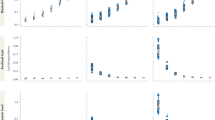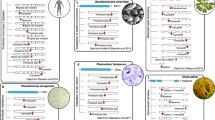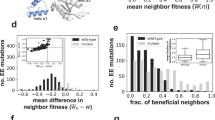Abstract
replying to D. M. McCandlish, E. Rajon, P. Shah, Y. Ding & J. B. Plotkin Nature 497, 10.1038/nature12219 (2013)
Understanding fitness landscapes, a conceptual depiction of the genotype-to-phenotype relationship, is crucial to many areas of biology. Two aspects of fitness landscapes are the focus of contemporary studies of molecular evolution. First, the local shape of the fitness landscape defined by the contribution of individual alleles to fitness that is independent of all genetic interactions. Second, the global, multidimensional fitness landscape1 shape determined by how interactions between alleles at different loci change each other’s fitness impact, or epistasis. In explaining the high amino-acid usage (u), we focused on the global shape of the fitness landscape2, ignoring the perturbations at individual sites3.
This is a preview of subscription content, access via your institution
Access options
Subscribe to this journal
Receive 51 print issues and online access
$199.00 per year
only $3.90 per issue
Buy this article
- Purchase on Springer Link
- Instant access to full article PDF
Prices may be subject to local taxes which are calculated during checkout

Similar content being viewed by others
References
Kondrashov, F. A. & Kondrashov, A. S. Multidimensional epistasis and the disadvantage of sex. Proc. Natl Acad. Sci. USA 98, 12089–12092 (2001)
Breen, M. S., Kemena, C., Vlasov, P. K., Notredame, C. & Kondrashov, F. A. Epistasis as the primary factor in molecular evolution. Nature 490, 535–538 (2012)
McCandlish, D. M., Rajon, E., Shah, P., Ding, Y. & Plotkin, J. B. The role of epistasis in protein evolution. Nature 497, E1–E2 (2013)
Kondrashov, A. S., Povolotskaya, I. S., Ivankov, D. N. & Kondrashov, F. A. Rate of sequence divergence under constant selection. Biol. Direct 5, 5 (2010)
Povolotskaya, I. S. & Kondrashov, F. A. Sequence space and the ongoing expansion of the protein universe. Nature 465, 922–926 (2010)
McVean, G. & Charlesworth, B. A population genetic model for the evolution of synonymous codon usage: patterns and predictions. Genet. Res. 74, 145–158 (1999)
Kondrashov, F. A., Ogurtsov, A. Y. & Kondrashov, A. S. Selection in favor of nucleotides G and C diversifies evolution rates and levels of polymorphism at mammalian synonymous sites. J. Theor. Biol. 240, 616–626 (2006)
Kimura, M. The role of compensatory neutral mutations in molecular evolution. J. Genet. 64, 7–19 (1985)
Author information
Authors and Affiliations
Corresponding author
PowerPoint slides
Rights and permissions
About this article
Cite this article
Breen, M., Kemena, C., Vlasov, P. et al. Breen et al. reply. Nature 497, E2–E3 (2013). https://doi.org/10.1038/nature12220
Published:
Issue Date:
DOI: https://doi.org/10.1038/nature12220
Comments
By submitting a comment you agree to abide by our Terms and Community Guidelines. If you find something abusive or that does not comply with our terms or guidelines please flag it as inappropriate.



